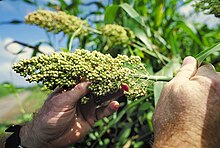Picue pigeons
| Picue pigeons | ||||||||||
|---|---|---|---|---|---|---|---|---|---|---|

Picue pigeon ( Columbina picui ) |
||||||||||
| Systematics | ||||||||||
|
||||||||||
| Scientific name | ||||||||||
| Columbina picui | ||||||||||
| ( Temminck , 1813) |
The picue pigeon ( Columbina picui ) is a species of pigeon bird that is part of the subfamily of American pigeons . The species occurs exclusively in South America. The species is not considered endangered.
Appearance
The picue pigeon reaches a body length of 18 centimeters. The species corresponds to the body size of a star and is slightly larger than a diamond pigeon . Compared to other species of the genus Columbina , the picue pigeon is somewhat longer-tailed. A gender dimorphism is present. The plumage of the female is generally a little more brown than that of the male.
The forehead and throat are greyish-white. The top of the head and the nape of the neck are ash gray. A very narrow black stripe runs from the base of the beak to the eye. The mantle and back as well as the wing covers and tail feathers are light brown-gray. The wings of the hand are black. The neck and chest are pale gray. Males have a pink sheen here, which the females lack. The belly is almost white. The beak is brownish gray. The feet are reddish. The iris is gray-blue.
Distribution area and way of life
The distribution area of the picue pigeon extends from southeastern Peru via Bolivia to the central area of Argentina. In a north-easterly direction it occurs in the north-east of Brazil to the Atlantic coast. On the southern edge of the Amazon, the range of this pigeon species is increasing as a result of clearing. The height distribution extends from the lowlands to heights of 3,700 meters above sea level. It is a widespread and regionally common pigeon species.
The habitat of the picue pigeon are arid and semi-arid habitats. Shrub savannah, open grasslands and agricultural areas are populated. In large parts of its distribution area, the Picuette is increasingly opening up human settlement space as a habitat. The species is predominantly ground dwelling. Usually she looks for food in small groups on the ground. The diet consists mainly of seeds. Of the agricultural crops, the seeds of sorghum are mainly eaten. The breeding season varies with the area of distribution. In Bolivia the Picue pigeon breeds in the period September to April; in Argentina, the breeding season begins in October and also ends in April. In northeastern Brazil, Picuit pigeons raise up to two broods in a year. In other parts of the distribution area there is only one clutch per year. The nest is built at a low height in shrubs or small thorny trees. The clutch consists of two eggs. Both parent birds breed. The breeding season is eleven to 13 days. The young birds leave the nest after twelve to 13 days.
Keeping in human care
The picue pigeon is only imported relatively seldom and therefore only plays a minor role in keeping wild pigeons. It was first shown at the Amsterdam Zoo in 1853. The first breeding took place in Germany in 1905.
supporting documents
Individual evidence
literature
- David Gibbs, Eustace Barnes and John Cox: Pigeons and Doves - A Guide to the Pigeons and Doves of the World . Pica Press, Sussex 2001, ISBN 90-74345-26-3 .
- Alois Münst and Josef Wolters: Tauben - The species of wild pigeons , 2nd expanded and revised edition, Verlag Karin Wolters, Bottrop 1999, ISBN 3-9801504-9-6 .
- Gerhard Rösler: The wild pigeons of the earth - free living, keeping and breeding . M. & H. Schaper Verlag, Alfeld-Hannover 1996, ISBN 3-7944-0184-0 .
Web links
- Columbina picui inthe IUCN 2013 Red List of Threatened Species . Listed by: BirdLife International, 2012. Retrieved October 31, 2013.
